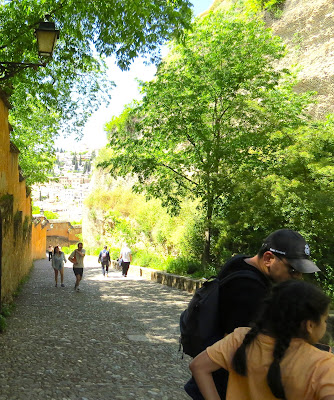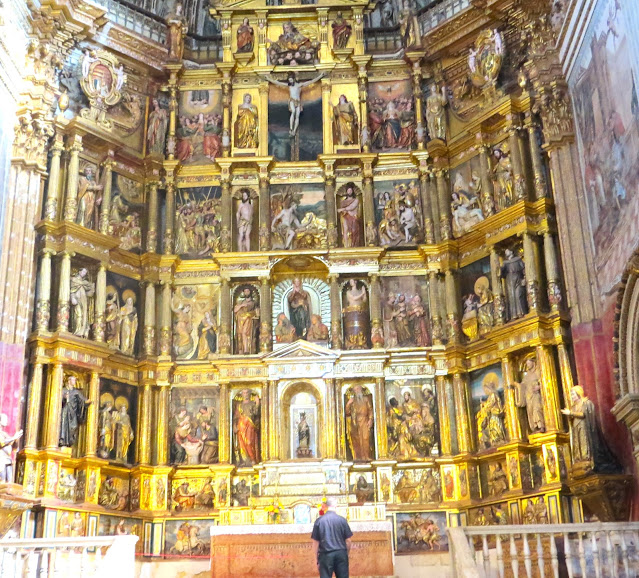We arrived in Granada on a Tuesday, April 23, as part of a six-week visit to Spain. We stayed four nights at the Palacio Gran Via, whose rooftop bar has views of both the Alhambra and the Granada cathedral. That gave us three full days. Wednesday was devoted to the Alhambra.
We took a taxi up extremely narrow and steep streets to the Alhambra entrance. Once there we realized that we could have taken a city bus. After our visit, our smart phone guided us to an easy but very long downhill path along a stream and away from streets that nonetheless returned us to familiar city streets. More energetic people take that path uphill to the Alhambra.
The Alhambra's construction was begun in 1238 by a Nasrid emir on the site of earlier fortifications. Granada thus became the last Muslim state of Al-Andalus, which at its greatest range included what is now Portugal, much of what is now Spain and a bit of southern France. By the 1300s, Nasrid rulers had added the palaces we see today. And by 1492, a notable year, Catholics had reconquered Granada and Isabella and Ferdinand set up their royal court in the Alhambra. It was here that the monarchs gave Christopher Columbus a royal endorsement to try to find a new route to India. (Isabella and Ferdinand are entombed in a chapel adjacent to the Granada cathedral. Columbus is entombed in the Seville cathedral.)
After falling into disrepair during centuries of neglect, the Alhambra was rediscovered in the early 1800s by British, northern European and American romantic intellectuals, including the American writer Washington Irving, whose "Tales of the Alhambra" was widely read and raised awareness of the site. We picked up two copies of his Alhambra stories for children as gifts. For the last two centuries, the Alhambra has been the focus of restoration and conservation efforts that pay off for today's visitors.
The cathedral, Santa Iglesia Catedral Metropolitana de la Encarnacion de Granada, should also be a must-see even if your eyes glaze over at the thought of another over-the-top Spanish cathedral. It has paintings at heights that must be intended only for the eyes of angels.
Around the corner, the tombs of Ferdinand and Isabella (no photography is allowed) are worth a quick visit. It's hard to imagine another royal couple in which each was just as important and powerful as the other, or any other monarch or monarchs who exercised such influence. They united the Catholic kingdoms of Spain and drove out the non-Catholics. This ethnic cleansing and the infamous Spanish Inquisition created a church-based nation state and caused an untold amount of human misery. Some towns in Spain, including the former royal capital of Toledo, at that time had substantial Catholic, Muslim and Jewish communities living quite peacefully with each other only to be torn apart. And. of course, the Catholic Monarchs, as they are called, expanded the world known to Europeans to include the Americas They also authorized the brutal looting of Inca, Aztec and other New World civilizations. The gold stolen from Peru and Mexico and elsewhere helped pay for the cathedrals and palaces of Spain. Isabella's piety is praised in signage at her tomb with no mention of the evil aspects of her reign.
The tree-lined Gran Via, the street our hotel is on, cuts through the warren of narrow old-quarter streets much like Haussman's boulevards in Paris. Across from our hotel, the cathedral sits among blocks and blocks of souvenir shops, restaurants and plazas.
It was on the hotel's roof terrace that we had what for us was an unusual experience. Earlier, we had run into two people we recognized coming out of an elevator at the hotel: Sandrine and Olivier Kretz of the Netflix show "The Parisian Agency: Exclusive Properties." Jane and I had seen the first three seasons and enjoyed the glimpses of Paris, almost everyone's favorite city, as well as watching the family's real estate endeavors. The show chronicles a reality-TV version of their lives as high-end real estate agents in Paris, working with their four sons, with listings and clients around Europe. Late one afternoon, when we were having aperitifs on the roof, someone with the show asked if we would mind being filmed. We had to sign waivers, and then it was us, another couple who appeared to be hotel guests, and a few hotel employees sitting at tables (with complimentary drinks) as Sandrine and Olivier walked to the table with the best view of the Alhambra. They had copper mugs for Moscow mules, but I bet they were empty. April 2025 update: We finally saw the episode, the sixth and final episode of the show's fifth season. It turns out that Sandrine and Olivier are in Grenada to celebrate their 40th wedding anniversary. We are two tables behind them. I'm visible with my gray hair and a black jacket. Jane is mostly obscured by a hotel employee who was at the table between us and the Kretzes. If you watch the scene carefully (and why would you do that?) you may notice that we disappear and reappear. We left before the shooting was finished because it was so chilly (Sandrine was wrapped in a tablecloth between takes), and the final edit of their conversation has us in and out of the background.
We had breakfast three mornings at Restaurante Rollo on the plaza in front of the cathedral. On this trip most hotels included a continental or buffet breakfast with the room, but at the five-star Palacio Gran Via, breakfast was an extra 25 euros per person each day. We ate out for a fraction of that.
We don't put much emphasis on lunches when we travel, though traditionally in Spain that's the main meal of the day. At the Alhambra, we shared a premade sandwich from a souvenir shop. But for lunch right after we arrived, we ended up sitting down at a restaurant that we later realized that our hotel had recommended, Cunini, on a Plaza Pescaderia (Fish Market Plaza) not far from the cathedral. Jane, who loves crab (we used to live on an island in crab-rich Chesapeake Bay) and has ordered various kinds of crabs from Seattle to Morocco to Cambodia, for the first time sent a crab dish back. It was a crab salad, which wasn't how it was described on the menu. Jane expected a whole crab that she could rip into and told the waiter, who nodded along, what she wanted. What finally came, long after I had eaten my grilled fish, was a crab that had been gutted, cracked and partially shelled. It was also cold and tasteless. Though Cunini seems to be a well-regarded restaurant, and we did watch a couple at another table devour large lobsters that looked great, we wouldn't recommend the crab or the service.
As in Madrid, tapas can be found everywhere in Granada, and we found ours on Calle Navas and its extension, Calle Virgen del Rosario. Together these streets from a restaurant/tapas row. Our first evening meal was at Entre Brasa, a lively beef-oriented restaurant but not so much a tapas joint. Very good but not what we were looking for. We ate two other evenings at Taberna Malvasia, and we go back only to places we really like. In fact, we ordered some of the same dishes again.
We had one other dinner in Granada, and it was part of a package at a flamenco club, Venta el Gallo. My veal steak was surprisingly good and the flamenco show ... well, you have to see at least one flamenco show if you're in southern Spain. And at family-operated Venta el Gallo, which is partly in a cave in the Roma district Sacromonte, it's easy to feel as if you're watching family members dancing for each other.
Here is tiny bit of video (Venta el Gallo doesn't have "no photography" signs but a waiter scolds you as soon as you raise your camera) that gives some idea of the venue and the show but fails to capture how entertaining it was:
And here are some snapshots from the rest of our time in Granada:
 |
| The Alhambra, photographed from the roof terrace of the Palacio Gran Via, our hotel. Most of what we see here is the Alcazaba, the fortified buildings. |
 |
| Tile work in the Nazaries Palaces dates to the 1300s and 1400s. Each tile had to be made and glazed by hand. |
 |
| A pool in the Nazaries Palaces. |
 |
| The terrace with the lions fountain is surrounded by lacy stonework and delicate columns. Probably the most photographed part of the Alhambra.  Windows in the palaces look down on Granada. |
 |
| Ornate arches surround terraces and lead from one room to another. |
 |
| A room in the palaces is covered in tiles. |
 |
| The Alcazaba as seen from just outside the Nazaries Palaces. |
 |
| The tower of the Alazaba. |
 |
| The walls of the Alcazaba overlook modern Granada. |
 |
| The Puerto del Vino. |
 |
| One of the gardens of the Generalife, a palace built in the 1300s for the emir and his court to use in the summer. It's higher than the adjacent Alhambra and presumably better cooled by breezes. Tickets to the Alhambra include tickets to the Generalife. |
 |
| The Generalife, to me at least, looks much more European than the other buildings here. |
 |
| The downhill path from the Alhambra to the city. |
 |
| The cloister at Monasterio de San Jeronimo surrounds an orange orchard. |
 |
| The interior of the monastery, which was commission by Queen Isabella in 1504, presumably as Spanish ships started returning with plundered gold from the New World. |
 |
| The altar at San Jeronimo exemplifies the approach that too much is never enough, |
 |
| The cathedral in Granada. |
 |
| The cathedral is immense. |
 |
| The cathedral's main altar, |
 |
| A side chapel at the cathedral is protected by iron bars. We saw similar bars at other cathedrals and churches in southern Spain, which often makes them seem like prisons. |
 |
| A street near the cathedral. |
 |
| Awnings create welcome shade in sunny Granada. Some streets had sheets of canvas stretched across them, anchored at the tops of buildings on each side of the street. |
 |
| Stones create patterns on a pedestrian street that connects the hilltop San Nicolas area with the lower downtown. |
.jpg) |
| Entre Brasas on Calle Navas is a beef-lovers place. |
 |
| Part of the menu at Taberna Malasia, a tapas joint on Calle Virgen del Rosario, just a few steps from Entre Brasa. Even though this place doesn't seem touristy at all, the menu is bilingual. |
 |
| The asparagus were great, by the way. |
 |
| And here's my favorite dish at Malvasia, toast with iberico ham and quail eggs. Almost anything that uses iberico ham (the product of a special breed of acorn-fed pigs) is going to be good, but this was exceptional. |



No comments:
Post a Comment